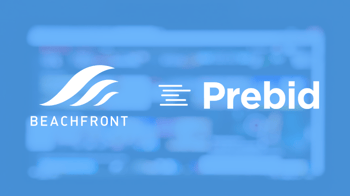Putting CTV Publishers in Control, As It Should Be
Published by Frank Sinton on

[This piece originally appeared on LinkedIn, here.]
Today, media owners and publishers increasingly rely on advertising as a key revenue driver -- which creates complex challenges, but also new opportunities in terms of monetizing their inventory.
On connected TVs, that’s also pushed the rise of ad-based video on-demand (AVOD) and free ad-supported television services (FASTs). However, CTV advertising needs aren’t like web-based ads -- there are no cookies, it’s a continuous stream of content and you don’t have a 1:1 ratio of ads to content. Coupled with the convergence of screens between traditional TV and digital video, it’s a complicated but crucial juggling act for publishers.
At Beachfront, we take pride in having the opportunity to partner with and support publishers, to help them solve the increasingly complex challenges they face. Each day brings something new, but today, that challenge increasingly lies in managing and monetizing video advertising -- while ensuring a pleasant viewer experience.
Despite the importance of these ad revenues and monetizing video inventory, there remains a scarcity of effective tools for publishers. It’s clear the industry has not done enough to meet their pressing needs. User sessions, in particular, can sometimes feel disregarded. Yet, they’re an integral consideration when accounting for binge watching, in particular.
The advanced TV viewer experience -- with issues around ad pods, frequency capping and ad quality -- leaves much to be desired. And advertisers, rightfully so, are more demanding than ever.
Publishers shouldn’t have to solve these issues on their own. They need a partner, someone who has their best interest in mind. They also need innovation, not empty promises.
That’s why I’m excited to share that earlier today, we introduced a new Pod Bidding solution -- that’s built on open source -- to help our publishers in the advanced TV space better manage their ad inventory and viewer experiences.
We’re really excited to bring this solution to market, and while there is still work to be done, we’re optimistic it will help ease some of the pains publishers currently face.
As we build out this solution in partnership with our publishers, we’re relying on four key beliefs:
- Publishers need CTV-focused decisioning engines. CTV has changed the game for a number of reasons, but much of the ad infrastructure is built on Web-based 1.0 tech. For AVOD publishers to flourish in a CTV world, they need better tools to optimize their inventory, such as pricing different slots in an Ad Pod/Ad Break.
- The viewer experience is paramount. As mentioned, one key revenue stream for publishers stems from the budget that advertiser’s invest in reaching engaged audiences. If the ad and viewing experience is poor (or latent), audiences may seek other options. No audience means no advertisers. No advertisers means no associated revenue.
- Publishers should always be in control. The fragmentation associated with programmatic has distanced publishers from the ad tech ecosystem and their ad buying partners. We have to make it easier for them to connect directly to demand sources and control both their auction engine and ad mechanics. It’s their inventory and content. They should control it fully.
- Transparency is critical. The ad ecosystem has become murky territory over the last decade, and it’s sowed seeds of distrust to a certain degree. Publishers not only need but deserve granular analytics and diagnostics, visibility into wrapped creatives and solutions built on open source that they can customize and whitelist.
As we move forward, the publishing and media industry will continue to evolve -- after all, it’s always-changing. We shouldn’t let those changes get in the way of what matters most: helping publishers deliver better experiences to their audiences.
It starts with CTV-focused decisioning engines, with an emphasis on viewer experience, with putting publishers in the driver's seat and with more transparency.



